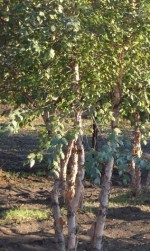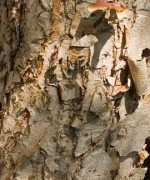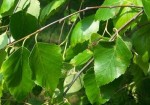 A native of low woods, streamsides, and riverbanks in the eastern part of the United States, from southern New England to northern Florida and west to Oklahoma and Kansas, river birch is a idea tree for wet or moist sites in sun to part shade. The upright tree is usually multi-stemmed and grows relatively quickly to 40-60 feet tall. The serrated leaves are shiny and medium green in spring and summer, turning pale yellow in the fall. The exfoliating bark may be cream or have a pinkish tinge at first but darkens to cinnamon brown as the tree matures. River birch can be used as a specimen, a shade tree, or as a hedge if cut back. Although it tolerates compacted soil it will not do well in an alkaline pH. Although it is more resistant to the pests and diseases that afflict other birches it is susceptible to ice damage. In the wild it can live for 60-75 years. River birch is a member of the birch family, Betulaceae, that also includes alders, hazels, and hornbeams. The genus name, Betula, is the classical Latin name for one of the genera. The specific epithet, nigra, is the Latin word for black/dark.
A native of low woods, streamsides, and riverbanks in the eastern part of the United States, from southern New England to northern Florida and west to Oklahoma and Kansas, river birch is a idea tree for wet or moist sites in sun to part shade. The upright tree is usually multi-stemmed and grows relatively quickly to 40-60 feet tall. The serrated leaves are shiny and medium green in spring and summer, turning pale yellow in the fall. The exfoliating bark may be cream or have a pinkish tinge at first but darkens to cinnamon brown as the tree matures. River birch can be used as a specimen, a shade tree, or as a hedge if cut back. Although it tolerates compacted soil it will not do well in an alkaline pH. Although it is more resistant to the pests and diseases that afflict other birches it is susceptible to ice damage. In the wild it can live for 60-75 years. River birch is a member of the birch family, Betulaceae, that also includes alders, hazels, and hornbeams. The genus name, Betula, is the classical Latin name for one of the genera. The specific epithet, nigra, is the Latin word for black/dark.
Type: Multi-stemmed tree

Outstanding Feature: Exfoliating bark; tolerates wet site.
Form: Upright; oval/pyramidal
Growth Rate: moderate-fast
Bloom: Small inconspicuous flowers produced in catkins in mid-spring
Size: 40-60’ H x 20-30’ wide
Light: Full sun
Soil: Average, wet to moist, well-drained
Hardiness: Zones 4-9
Care: Prune out dead branches any time of year.
Pests and Diseases: Susceptible to various rots and decays, gypsy moth, Japanese beetle, yellownecked caterpillar, mites; chlorosis on high pH soil.
Propagation:Seed; softwood cuttings

Outstanding Cultivars:

-
- ‘Heritage’ (excellent bark coloration, fast growth, heat tolerant)

- ‘Little King’ (dwarf form ,15-20’ tall with good peeling bark.

How would I trim it as a hedge?